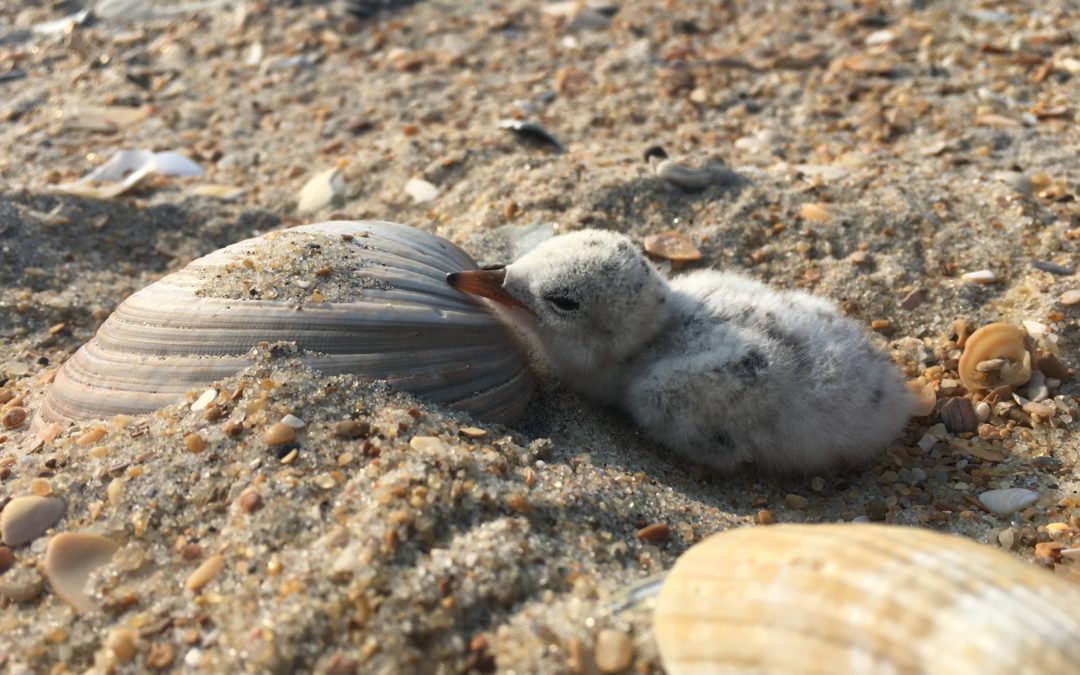By Abby Burke, Biological Science Technician at Cape Hatteras National Seashore
Why are sections of the beach closed for shorebirds?
This is by far one of the most common questions we get as bio techs. The answer lies in shorebird nesting strategies and chick behavior.
You may be familiar with how a forest songbird creates a large nest of sticks up in a tree or a perch to hold their eggs. When the eggs hatch, the chicks stay in the nest and the adult birds bring food to them. Shorebirds are the exact opposite.
Shorebirds nest directly on the beach just above the high tide line and rely on incredible camouflage to avoid predation. Chicks are mobile minutes after hatching and utilize the entire beach from dunes to the water to forage for food.
The birds, eggs, and chicks are all close in color to the sand, and nests are typically a small divot the bird creates in the sand. Unfortunately, it is this same camouflage that makes nests, incubating adults, and chicks difficult for people to spot even up close. Even a well-intentioned individual can miss a shorebird nest or chick.

It is also important to understand that a shorebird sees you, your dog, and your car as predators. If any of these get too close to the shorebirds, nests, or chicks they are under high stress. If the chicks have not hatched yet, the nest must be incubated constantly for around a month for the chicks to hatch. If you, the predator, are too close to the nest, then the bird will fly off to try to deceive you. As a result, the nest is both not incubated and not guarded from predators while you are in the area.
Once the nest has hatched, a shorebird chick’s main defense in these situations is still camouflage. A chick will stop moving or eating and crouch low on the sand, often in a depression, or nestle in seaweed to blend in. In areas where people are recreating, they are susceptible to getting stepped on or run over. Remember, chicks cannot fly for at least a month. The entire time a shorebird is disturbed by a predator they are working to steer away the predator and warn their chicks and mate. During this time, the birds are not eating or sheltering and are in a high state of stress and energy utilization. The adults are now focused on removing you, the predator, and not on what their chicks are presently doing, leading to increased danger to the chicks.
How and why are shorebirds protected?
The shorebird species that receive closures for their nests and chicks are on the endangered species list in some form or are a species of special concern in our state and are all protected via the Migratory Bird Treaty Act of 1918. Additionally, the National Park Service regulations do not allow the disturbance of wildlife nesting, breeding, or other activities. Above the hightide line, on sandy beaches at seashores, is the only place these birds nest and raise their young. Due to predation as well as habitat loss via beach recreation, development, and erosion from storms, many shorebird populations are decreasing.
Studies have determined the minimum distance people can be from nesting shorebirds without disturbing them. Every shorebird closure at Cape Hatteras National Seashore is measured to this distance to afford beachgoers the maximum amount of accessible beach. When a bird pair renests or when chicks are on the move, the closures are adjusted by resource management technicians to maintain the minimum buffer distance the birds and chicks for minimal disturbance and to provide the maximum amount of open beach for recreation.

What can I do to help?
The best thing visitors can do to help protect nesting shorebirds is to not enter the sections of the beach closed for shorebird nesting. This may require reading posted signage and being aware of changing signage as you walk/drive on the beach. Always keep your pets on a maximum six-foot leash, as required by the Superintendent’s Compendium.
In addition, packing in and packing out trash, including fishing bait scraps, will discourage mammalian predators from being attracted to areas where shorebirds are nesting.
If you see other visitors entering these areas or a shorebird in danger, contact Dare County non-emergency dispatch number: (252) 473-3444.
About Abby
Abby Burke is from Cape Cod, Massachusetts. She graduated from Salve Regina University in Rhode Island in 2019. She has been working as a BioTech since 2017. She spent a season at Cape Lookout National Seashore before working at Cape Cod National Seashore for five seasons. In the off-season, she’s worked at Yellowstone National Park, Canyonlands National Park, the Lemur Conservation Foundation, the Maine Department of Inland Fisheries and Wildlife, the Nature Conservancy, Mass Audubon, and the Army Corps of Engineers. This is her first season at Cape Hatteras National Seashore! In her spare time she enjoys mountain biking, tennis, and listening to Elton John.


Such a great article! Very informative and a great photo of the chicks.
Abby,
Very interesting, educational article you wrote!! I learned soo much reading it! It is amazing to me how those poor chicks make it to adulthood!! Wish all the public could read this article, since it clearly explains how important the safe areas of the beach area are for the birds!